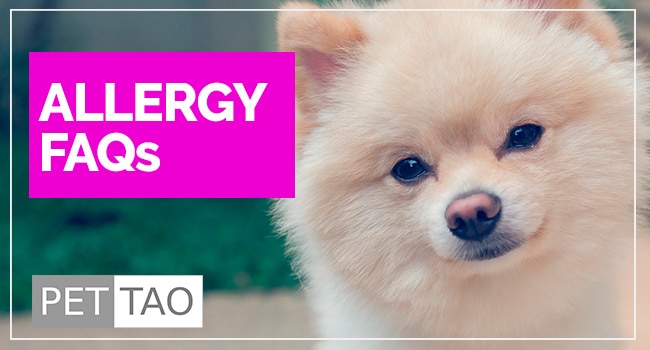Sometimes allergy medicine for dogs is the only thing that works.
Here’s why.
Dog allergies are a vicious cycle.
One symptom causes another, which causes the first symptom to worsen.
If you’ve had a pet with allergies, you know there’s always more than one instigator.
Always more than one issue.
Allergies are one of the most frequent conditions I see in my clinic.
Here are some of the questions about allergy medicine for dogs I hear over and over I hope you learn something from them!
1. What Are Secondary Infections?
Secondary infections, most frequently yeast and/or bacteria, result from dog allergies and intensify the signs associated with allergies.
Managing secondary infections is a critical part of treating canine skin allergies.
For dogs with superficial pyoderma, at least 3 weeks of an appropriate antibiotic is recommended.
If deep pyoderma is present, 4-8 weeks of antibiotics may be necessary.
A good antibacterial shampoo scrubbing will assist in the resolution of the infection.
If Malassezia dermatitis is present, topical therapy alone or in conjunction with systemic antifungal therapy should be utilized.
2. What Are the Best Topical Treatments?
Baths
Cool water baths with oatmeal shampoo decrease itching by soothing the skin and washing away inflammatory mediators and potential allergens.
Colloidal oatmeal is a safe and relatively effective antipruritic.
Topical Anesthetics
Topical anesthetics are also available and may have temporary antipruritic effects.
Pramoxine has been the topical anesthetic of choice in veterinary medicine.
Pramoxine is usually combined in shampoo or rinses with colloidal oatmeal.
Colloidal oatmeal products, with or without additional ingredients, are most useful for mild pruritus.
Lime sulfur (LymDyp®, DVM Pharmaceuticals)
Lime sulfur is a very effective, nonsteroidal antipruritic.
Because it is applied as a rinse and allowed to dry on the animal, it provides a residual effect.
Lime sulfur is safe for use in both dogs and cats.
In addition to its antipruritic effects, lime sulfur is antiparasitic and antifungal.
Topical corticosteroids
Topical corticosteroids are very effective antipruritic drugs and are commonly used in the treatment of canine seasonal allergies.
3. Which Products Contain Corticosteroids?
Several dog allergy medicines contain corticosteroids.
CortiSoothe® (Virbac) is a 1% hydrocortisone-containing shampoo with a colloidal oatmeal base.
Capex® shampoo (formerly known as F/S Shampoo) contains 0.01% fluocinolone acetonide.
Genesis Topical Spray® (Virbac) is a 0.015% triamcinolone spray, FDA approved for generalized use for dogs.
In a blinded, placebo-controlled study of 103 dogs with pruritus of various causes, 67% showed significant reductions in erythema, pruritus, and eruption over 28 days.
The study showed hematological and biochemical results of treated dogs did not change significantly over the course of treatment.
In a separate study, corticosteroids proved effective in treating dog flea allergy dermatitis symptoms.
This product is intended for generalized use over short periods of time (28 days or less) as an alternative to oral or injectable corticosteroids.
4. What About the Home Remedy Benadryl?
Benadryl is an antihistamine.
Histamine is a potent inflammatory mediator released by activated cells and might be a major initiator of itching in the dog.
Accordingly, vets often recommend antihistamines to alleviate itching.
The most common dog allergy medicines are Benadryl and Hydroxyzine.
Because first-generation antihistamines readily cross the blood-brain barrier, they may lead to increased sedation.
Benadryl commonly sedates dogs.
Roughly 30% of patients using Benadryl experience significant improvement.
Tricyclic antidepressant (TCA) drugs, amitriptyline, and doxepin also help control dog itchiness.
5. What Are the Doses of Antihistamines for Dogs?
Dog allergy medicine dosages:
- Diphenhydramine (Benadryl) 2.2 mg/kg q 8 hrs.
- Hydroxyzine HCl (Atarax) or pamoate 2.2 mg/kg q 8 hrs.
- Chlorpheniramine (Chlor-Trimeton) 0.2-0.8 mg/kg q 8 hrs.
- Clemastine fumarate (Tavist) 0.05-0.1 mg/kg q 12 hrs
- Loratidine (Clariton) 10 mg/dog q 24 hrs
- Cetirizine (Zyrtec) 5-10 mg / dog q 24 hrs
- Amitriptyline (Elavil) 1-2 mg/kg q 12 hrs.
- Doxepin (Sinequan) 1-2 mg/kg q 12 hrs.
6. Can I Use Fish Oil?
Fatty acid supplements are beneficial in the management of canine allergy symptoms.
Numerous veterinary and over-the-counter dog allergy medicines are available.
Very few fish products have good critically-evaluated scientific studies available for review.
However, we do have a double-blinded, placebo-controlled study using high doses of marine fish oils (180 mg EPA and 120 mg DHA per 10 # body weight).
In this study, treated dogs had significantly less pruritus and alopecia, and significantly better hair coat quality than placebo-treated dogs.
Therefore, some diets have been fortified with essential fatty acids.
Before essential fatty acids create change in the inflammatory cycle, they must penetrate the cell membrane.
So, it may take up to eight (8) weeks to notice improvement.
Side effects due to fatty acid supplements are rare but may include pancreatitis, weight gain, diarrhea, flatulence, and fish-breath.
In addition, high doses of fatty acids may affect platelet aggregation, so use in dogs with known coagulation problems is contraindicated.
Powerful Tools for Overcoming Dog Allergy Challenges
There are many quick and easy changes you can make at home to help you give your dog an edge on easing allergy challenges.
- Learn more about dog allergies.
- Switch to a Limited Ingredient Diet. PET | TAO Limited Ingredient Diet is naturally low in foods that stimulate an allergic response.
- Supplement with medicinal mushrooms. PET | TAO Complement Immune Mushroom Blend eases inflammatory response and allergy symptoms.
- Try digestive enzymes and probiotics. PET | TAO Harmonize Gi boosts gut health and combats food allergens.
- Feed Freeze Dried Lung Treats. According to TCVM, Lung is on the same meridian as the skin. Therefore, lung treats help both breathing and skin allergies. Lung treats support lung and skin similar to a glandular supplement in a “like treats like” fashion.
- Learn more about TCVM Herbal Remedies. Chinese medicine offers many amazing natural solutions for dog allergies Some good examples are:
Get A Phone Consultation with One of Our TCVM Veterinarians








